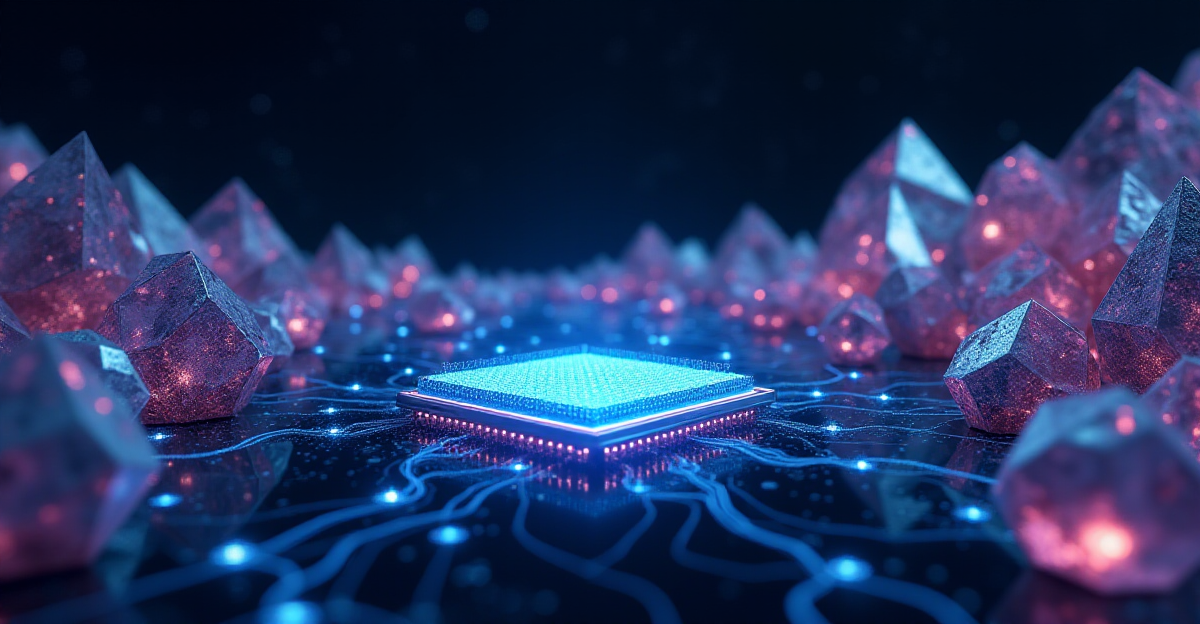Unconventional worlds of quasicrystals are becoming a possible pillar for innovative computer systems. Developing quasicrystal-based electronic devices has let me discover their remarkable information processing capability. These materials have special qualities that might circumvent present constraints in computer chip design based on their mathematically forbidden symmetry. Manufacturing stable quasicrystal structures recently produced fresh opportunities for applications in quantum computers. The non-periodic character of quasicrystals presents fresh ways to apply parallel processing and neural networks. Quasicrystal-based circuits have been found to be less power-consuming than conventional semiconductors yet could run at higher frequencies Quasicrystals’ special electron activity may allow quantum information processing and fresh methods of memory storage. These compounds subvert our basic knowledge of crystalline structure and electrical behavior. Using quasicrystal computing could result in computers that replicate natural systems in their information processing.
Table of Contents
- Beyond Periodic Crystals in Computing
- Quantum Applications of Forbidden Symmetries
- Bio-Inspired Processing Architecture
- Extra’s:
Beyond Periodic Crystals in Computing

Imagine a time when computers will be far quicker, more energy-efficient, able to solve hitherto unachievable tasks. Thanks to the fascinating possibilities of quasicrystals, this future may be closer than we realize. By providing a whole fresh approach to manufacture CPUs and memory, these materials could transform computing and maybe bring in a new age of novel computing.
Unlocking New Computational Capabilities
Quasicrystals have a different, non-periodic structure than conventional crystals, whose atoms are set in a precisely repeating pattern. Showing forbidden symmetries, they display a complicated, non-repeating pattern. These special qualities make them perfect for developing fresh computational architectures and transforming the direction of computing.
Developing neural networks using quasicrystals is one of the most exciting directions of inquiry. Inspired by the human brain, these artificial intelligence networks could help to create more intelligent machines able to learn and adapt like humans. Imagine devices that can learn and adapt like humans, therefore changing our interactions with technology. By developing new quantum information processors using quasicrystals, computing’s limitations could be pushed aside.
The Promise of Quasicrystals in Computing
Imagine a non-quite repeating mosaic tile pattern. This is the reason quasicrystals are so fascinating and the secret to their possible transformation of computers. Revolutionary quantum processors far more powerful than anything we have today could find their path via quasicrystals. For computing, these materials potentially have several benefits over conventional silicon-based electronic materials.
Before we can fully appreciate quasicrystals’ possibilities in computing, though, numerous obstacles still need to be addressed. Creating novel approaches for nanoscale quasicrystaline synthesis and manipulation presents one of the toughest difficulties.
Notwithstanding these difficulties, quasicrystals have great promise for computers. Around the globe, scientists are laboring to reveal the secrets of these intriguing materials. Research into quasicrystals is evidence of our creativity and our unrelenting search of limits of possibility. We are about to undergo a revolution that might permanently alter our interaction with technology as we keep discovering these unusual materials.
Quantum Applications of Forbidden Symmetries

Imagine a time when thanks to quantum sensors driven by a new class of materials known as quasicrystals, medical imaging is faster and more accurate. With their unusual, non-periodic structure, these materials hold the key to opening a new computing age. Ever wonder how researchers are transforming the field of technology utilizing forgotten symmetries? Let’s explore the amazing world of quasicrystals and their possible influence on our daily lives, employment, and interactions with the surroundings.
The Promise of Forbidden Symmetries
Unlike conventional crystals with their exactly repeating atomic patterns, quasicrystals have an amazing, non-periodic structure. This odd atom configuration opens fascinating developments in computational architecture and electronic materials. This special construction shows forbidden symmetries, which are symmetry patterns hitherto regarded as mathematically impossible. Consider it as a really mind-bending idea: discovering a new form that defies any of the current geometric classification!
Unlocking New Possibilities in Quantum Computing
Quasicrystals have among their most fascinating uses in their ability to produce quantum processors. Using the ideas of quantum mechanics, quantum computers run computations much beyond the reach of traditional computers. By allowing qubits—which can exist in several states concurrently—to be used in computations far quicker and with more complexity than conventional computers, they enable Known as novel computing, this fresh method uses the special qualities of these materials to address challenging problems that conventional computers struggle with. Novel computing solves difficult difficulties that conventional computers find using the special qualities of these materials.
Imagine a society in which human-like learning and adaptation of robots changes our interaction with technology. We are building quantum processors employing quasicrystals for uses including drug development, where novel drugs must be developed by simulating intricate chemical interactions. Researchers are looking, for instance, at how quasicrystals might be used to create novel medications to combat Alzheimer’s illness or cancer. Furthermore, by allowing the construction of new materials with improved characteristics—such as building lighter and stronger materials for automobiles or aircraft—these processors might transform materials research. By addressing complex financial computations, they could even change financial modeling and maybe result in more accurate forecasts of market patterns. Inspired by the human brain and able to process information in parallel, which results in more effective computation, the non-periodic structure of quasicrystals provides new approaches to create neural networks.
Although our trip with quasicrystals is just getting started, the potential is rather great. Investigating these unusual materials will uncover a universe of opportunities that might permanently alter our interaction with technology. Quasicrystals’ special qualities make them interesting candidates for creating creative computational architectures, therefore ushering a new era of strong and effective computing. These advances center on quantum information, as researchers investigate how to transform computers using the quantum features of various materials.
Bio-Inspired Processing Architecture

Ever wonder how the human brain picks up new knowledge and quickly analyzes data? As scientists work to better grasp the complexity of the brain, quasicrystal computing is one fascinating field of study meant to replicate its extraordinary power. Imagine a time when computers will be able to solve complex issues, adjust depending on experience, and perhaps grasp human emotions. Let us explore the intriguing field of quasicrystal computing, its capacity to transform the computing scene, and its connection to “quantum information processing.”
The Uniqueness of Quasicrystals
Conventional computers depend on periodic crystals, materials having repeating atom configurations. But quasicrystal computing veers another direction. It makes use of quasicrystals, materials with distinct, non-repeating atomic patterns. Imagine a mosaic tile design that never exactly repeats—that is the elegance of quasicrystals! This unusual construction gives quasicrystals unique qualities, including forbidden symmetries, which subvert our traditional wisdom of geometry.
These unique qualities provide a fresh way to developing and manufacturing CPUs and memory, therefore heralding a new era of computing. Computers more quicker, more energy-efficient, and able to solve problems beyond the capability of conventional computers could result from quasicrystal computing The possibilities are countless: computers may help doctors diagnose diseases, analyze vast amounts of data to forecast natural disasters, or provide individualized learning experiences for each student.
A New Frontier in Quantum Information Processing
Quasicrystal computing has among its most fascinating features the possibility for “quantum information processing,” which employs quantum mechanical ideas to do computations. This could result in revolutionary developments in materials research, drug discovery, and cryptography among other disciplines. Developing new quantum processors could find a platform thanks to quasicrystal computing, therefore ushering a new era of computational capability. Imagine computers solving issues thought impossible today; such is the transforming potential of “quantum information processing.”
Already finding use in fields including electronic materials and neural networks are quasicrystals. These disciplines could be transformed by quasicrystal computing, which will help to create more complex and effective computing architectures. Quasicrystals could be utilized, for instance, to design fresh kinds of transistors faster and more energy-efficient than their conventional counterparts. They might also be utilized to create artificial intelligence’s more strong and effective neural networks.
As a game-changer in the field of computing, quasicrystal computing has great potential to unlock a future of hitherto unthinkable opportunities. Faster, more intelligent computers could result from its capacity to reflect the operations of the brain. Unlocking a new degree of computer capability and revolutionizing sectors including medicine, materials science, and artificial intelligence, quasicrystal computing could also open the path for a new era of quantum processing.
Extra’s:
If you’re fascinated by the mind-bending possibilities of quasicrystals, you might enjoy exploring the concept of “Sonic Black Holes: Creating Universe Analogues in the Laboratory.” These fascinating structures mimic the behavior of black holes, providing a unique platform for studying fundamental physics. Another intriguing concept that intersects with the world of quantum mechanics is “Quantum Friction: The Strange Force Slowing Down Atomic Clocks.” This post delves into the mysterious forces that can affect the precision of atomic clocks, highlighting the intricate interplay between quantum phenomena and timekeeping.
For further exploration of the exciting potential of quasicrystals in quantum computing, you can delve into the world of “Moiré Quasicrystals & Topological Quantum Computing: A New Frontier | by Marcelo Maciel Amaral | Medium.” This article explores how moiré quasicrystals, a specific type of quasicrystal, hold the key to unlocking new avenues in topological quantum computing. To delve deeper into the scientific research on this topic, consider checking out “Phys. Rev. B 110, 134508 (2024) – Topological superconductivity in Fibonacci quasicrystals.” This research paper provides insights into the intriguing world of topological superconductivity in Fibonacci quasicrystals, a type of quasicrystal with fascinating properties.












1 thought on “Quasicrystal Computing: The Forbidden Symmetries Powering Next-Gen Processors”